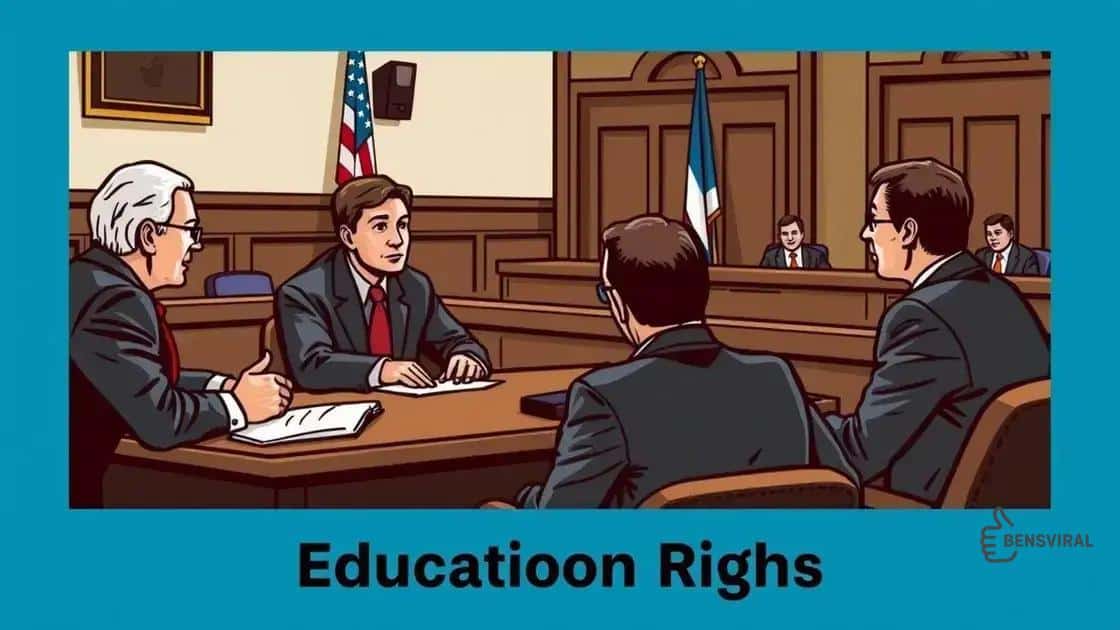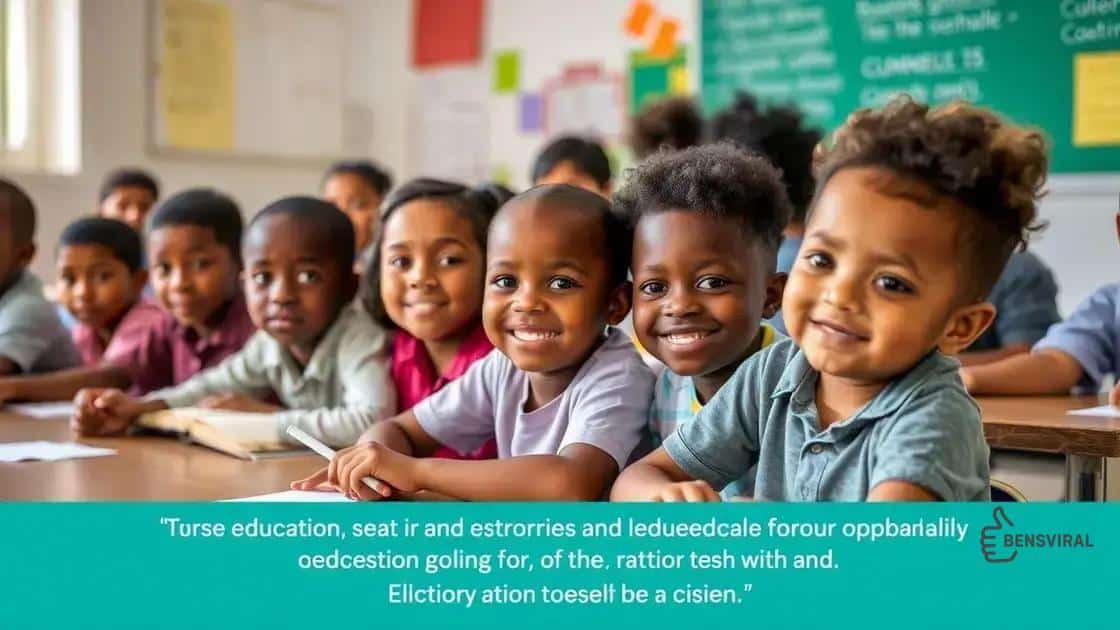Legal challenge to the Plyler v. Doe ruling: what’s next?

The legal challenge to the Plyler v. Doe ruling questions the right of undocumented children to access education, with potential outcomes that could significantly alter public education policies across the United States.
Legal challenge to the Plyler v. Doe ruling has sparked intense debate. What does this mean for students and their access to education? Let’s dive into the key issues at play.
Overview of Plyler v. Doe ruling
The Plyler v. Doe ruling is a landmark decision in U.S. legal history. In 1982, the Supreme Court ruled that states cannot deny free public education to children who are undocumented immigrants. This case highlighted the importance of education as a fundamental right.
The ruling emerged from a Texas law that aimed to charge tuition to undocumented children. The Court found this law unconstitutional, asserting that it violated the Equal Protection Clause of the Fourteenth Amendment.
Key points about the ruling
The Court’s decision was influenced by several key factors:
- The social and economic costs of excluding children from education.
- The impact on society of an uneducated population.
- The rights of children to receive education, irrespective of their immigration status.
This ruling has had a lasting impact on educational access for undocumented students across the country. As discussions about immigration policy continue, Plyler v. Doe remains a foundational case that advocates cite when fighting for equal access to education.
In many states, the ruling helps protect the rights of vulnerable populations, ensuring that educational resources are available to all children. The implications of Plyler v. Doe are profound, as they assert that education should not be contingent upon immigration status but rather be a basic right afforded to every child. As such, this legal precedent is a crucial aspect of ongoing debates about immigration and educational policies in the U.S.
Key arguments in the legal challenge
In the ongoing legal challenge to the Plyler v. Doe ruling, several key arguments have emerged. Each argument adds depth to the discussion about educational access for undocumented children. Understanding these points is crucial for grasping the stakes involved.
Argument 1: State rights versus federal mandates
One major aspect is the tension between state rights and federal mandates. Proponents of the challenge argue that states should have the authority to regulate education. They believe states should decide who qualifies for public schooling based on local resources and laws.
Argument 2: Financial implications
Another significant argument centers around financial implications. Opponents of the ruling claim that allowing undocumented children access to public education places a burden on state budgets. They argue that financial resources are limited, and public schools must prioritize residents.
Argument 3: Legal precedent
Supporters of Plyler v. Doe assert that overturning the ruling could set a dangerous precedent. They express concern that this challenge might undermine other educational rights, creating barriers for marginalized groups.
As these arguments unfold in court, they reflect the broader societal debate about immigration and education. Lawmakers and citizens alike are engaged, discussing what it means to offer education to all children. Each side presents compelling points that resonate deeply with different audiences, illustrating the complexity of the issue.
Ultimately, the discussions around these arguments shape public opinion. More importantly, they could have lasting impacts on how schools operate in the future, especially concerning access to educational resources for undocumented children.
Implications for education policy

The implications for education policy stemming from the Plyler v. Doe ruling are vast and significant. This case fundamentally shaped how educational institutions approach the enrollment of undocumented children. By ensuring that these children have access to public education, the ruling promotes inclusivity and equality in the system.
Increased enrollment in public schools
One immediate implication is the increased enrollment of undocumented children in public schools across the country. This has led to a more diverse classroom environment, where students bring unique perspectives. Schools must adapt to meet the needs of all students, including language support and additional resources.
Funding challenges
Another critical aspect involves funding. With the influx of students, some districts face challenges in securing adequate resources. These challenges can lead to budgetary constraints, making it essential for policymakers to find new funding solutions.
As a result, discussions about how to allocate resources fairly are ongoing. Educational policies must evolve to ensure that all children, regardless of their immigration status, receive quality education. The implications of Plyler v. Doe continue to resonate as schools navigate the complexities of funding and resource allocation.
Furthermore, this ruling has prompted discussions about state and federal responsibilities in education. Policymakers are increasingly recognizing the need for collaboration between different levels of government. This collaboration is vital to address the challenges associated with undocumented students in the educational system.
Overall, the implications for education policy extend beyond the classroom. They touch on social equity, community integration, and the future of the workforce. By examining these aspects, we can appreciate how the Plyler v. Doe ruling shapes not only education but society as a whole.
Potential outcomes of the case
The potential outcomes of the Plyler v. Doe legal challenge carry significant weight for education and immigration policies. The court’s decision could reshape the landscape for countless undocumented children seeking education. Understanding these potential outcomes helps to grasp the gravity of this ongoing legal battle.
Outcome 1: Overturning the ruling
If the Supreme Court were to overturn Plyler v. Doe, it could lead to states having the authority to deny education to undocumented children. This would likely create barriers for many students, impacting their future opportunities and overall societal integration.
Outcome 2: Upholding the ruling
Conversely, if the ruling is upheld, it reinforces the idea that education is a fundamental right for all children, regardless of immigration status. Upholding this decision supports inclusive education policies and ensures that schools continue to serve diverse students.
Other potential implications
Beyond these two primary outcomes, several other consequences could arise:
- Increased state funding for services supporting undocumented students.
- Heightened debates on immigration policy at both state and federal levels.
- Potential legal challenges to other educational rights based on the outcome.
As these discussions unfold, they reflect larger societal attitudes toward immigration and education. The implications of this case extend beyond the classroom, impacting families, communities, and future generations.
Furthermore, stakeholders such as educators, lawmakers, and advocacy groups are closely monitoring these developments. Their reactions could influence future policies related to educational access and equity.
Voices of affected communities
The voices of affected communities play a vital role in the conversation surrounding the Plyler v. Doe ruling and its implications. These voices are often overlooked but provide essential insights into the real-life effects of immigration laws on education.
Personal Stories
Many individuals have been directly impacted by the ruling. These personal stories highlight the struggles and triumphs of undocumented students. For instance, students have shared how having access to education has changed their lives, allowing them to pursue their dreams and contribute to society.
Community Advocacy
Community organizations also amplify these voices. They work tirelessly to advocate for the rights of undocumented children. Their efforts range from providing educational resources to lobbying for policies that protect students’ rights.
- Legal assistance to navigate educational rights.
- Workshops on available resources for undocumented students.
- Campaigns to raise awareness about the importance of inclusive education.
These advocacy groups give a platform to those affected, making sure their stories and needs are heard. They emphasize that education is a fundamental right, not just for some, but for all children, regardless of their immigration status.
The power of community voices extends to public forums and local governments, where discussions about education policies are taking place. These contexts allow community members to share their experiences and push for change in the system.
Ultimately, the narratives from affected communities serve as a reminder of why the Plyler v. Doe case matters. Listening to these voices can inspire action and drive policy change, reinforcing the significance of education as a right that should be accessible to everyone.
FAQ – Questions about the Plyler v. Doe Ruling and Its Impact
What is the Plyler v. Doe ruling?
The Plyler v. Doe ruling is a landmark Supreme Court decision that ensures undocumented children have the right to access free public education.
How does the ruling affect schools today?
The ruling impacts how schools enroll students, requiring them to provide education to all children, regardless of immigration status.
What are the potential outcomes of the current legal challenge?
The outcomes could either uphold the ruling, ensuring continued access to education for undocumented children, or overturn it, potentially creating barriers.
Why is it important to listen to the voices of affected communities?
Listening to affected communities helps raise awareness about their needs and challenges, fostering advocacy for their rights to education.






